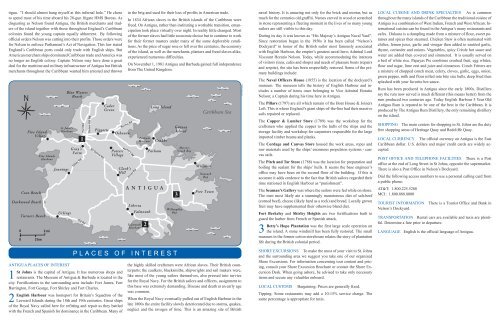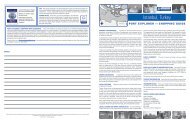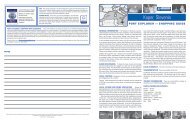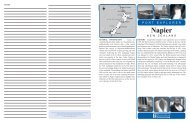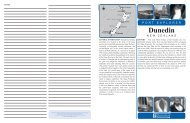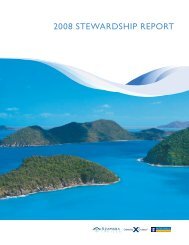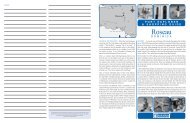St Johns
SHOPPING GUIDE - Royal Caribbean
SHOPPING GUIDE - Royal Caribbean
- No tags were found...
You also want an ePaper? Increase the reach of your titles
YUMPU automatically turns print PDFs into web optimized ePapers that Google loves.
tigua. “I should almost hang myself at this infernal hole.” He chose<br />
to spend most of his time aboard his 28-gun frigate HMS Boreas. As<br />
disgusting as Nelson found Antigua, the British merchants and traders<br />
of the island together with those throughout England’s Caribbean<br />
colonies found the young captain equally abhorrent. By following<br />
official orders Nelson was cutting into their profits. Those orders were<br />
for Nelson to enforce Parliament’s Act of Navigation. This law stated<br />
England’s Caribbean ports could only trade with English ships. But<br />
American merchant ships dominated Caribbean trade and America was<br />
no longer an English colony. Captain Nelson may have done a great<br />
deal for the maritime and military infrastructure of Antigua but British<br />
merchants throughout the Caribbean wanted him arrested and thrown<br />
1<br />
in the brig and sued for their loss of profits in American trade.<br />
In 1834 African slaves in the British islands of the Caribbean were<br />
freed. On Antigua, rather than instituting a workable transition, emancipation<br />
took place virtually over night. In reality little changed. Most<br />
of the former slaves had little economic choice but to continue to work<br />
for their former masters under many of the same deplorable conditions.<br />
As the price of sugar rose or fell over the centuries, the economy<br />
of the island, as well as the merchants, planters and freed slaves alike,<br />
experienced numerous difficulties.<br />
On November 1, 1981 Antigua and Barbuda gained full independence<br />
from The United Kingdom.<br />
2<br />
3<br />
© 2010 maps.com<br />
naval history. It is amazing not only for the brick and mortar, but as<br />
much for the centuries old graffiti. Names carved in wood or scratched<br />
in stone representing a fleeting moment in the lives of so many young<br />
sailors are still visible to this day.<br />
During its day it was known as “His Majesty’s Antigua Naval Yard”.<br />
Since restoration began in the 1950s it has been called “Nelson’s<br />
Dockyard” in honor of the British sailor most famously associated<br />
with English Harbour, the empire’s greatest naval hero; Admiral Lord<br />
Viscount Horatio Nelson. Today, while accommodating the interests<br />
of visitors (inns, cafes and shops) and needs of pleasure boats (repairs<br />
and respite), the site has been respectfully restored. Some of the primary<br />
buildings include:<br />
The Naval Officers House (1855) is the location of the dockyard’s<br />
museum. The museum tells the history of English Harbour and includes<br />
a number of items once belonging to Vice Admiral Horatio<br />
Nelson; a Captain during his time here in Antigua.<br />
The Pillars (1797) are all which remain of the Boat House & Joiners<br />
Loft. This is where England’s giant ships-of-the-line had their massive<br />
sails repaired or replaced.<br />
The Copper & Lumber <strong>St</strong>ore (1789) was the workshop for the<br />
craftsmen who applied the copper to the hulls of the ships and the<br />
storage facility and workshop for carpenters responsible for the large<br />
imported timber beams and planks.<br />
The Cordage and Canvas <strong>St</strong>ore housed the work areas, ropes and<br />
raw materials used by the ships’ enormous propulsion systems - canvas<br />
sails.<br />
The Pitch and Tar <strong>St</strong>ore (1788) was the location for preparation and<br />
boiling the sealant for the ships’ hulls. It seems the base engineer’s<br />
office may have been on the second floor of the building. If this is<br />
accurate it adds credence to the fact that British sailors regarded their<br />
time stationed in English Harbour as “punishment”.<br />
The Seaman’s Gallery was where the sailors were fed while on shore.<br />
The men most likely ate a stunningly monotonous diet of salt-beef<br />
(corned beef), cheese (likely hard as a rock) and bread. Locally grown<br />
fruit may have supplemented their otherwise bland diet.<br />
Fort Berkeley and Shirley Heights are two fortifications built to<br />
guard the harbor from French or Spanish attack.<br />
3<br />
Betty’s Hope Plantation was the first large scale operation on<br />
the island. A stone windmill has been fully restored. The small<br />
museum in the former cotton storehouse relates the story of plantation<br />
life during the British colonial period.<br />
Local Cuisine and Drink Specialties As is common<br />
throughout the many islands of the Caribbean the traditional cuisine of<br />
Antigua is a combination of West Indian, French and West African. International<br />
cuisine can be found in the Antigua’s many restaurants and<br />
cafes. Dukuna is a dumpling made from a mixture of flour, sweet potatoes<br />
and spices then steamed. Chicken <strong>St</strong>ew is often marinated with<br />
chilies, lemon juice, garlic and vinegar then added to sautéed garlic,<br />
thyme, coriander and onions. Vegetables, spicy Créole hot sauce and<br />
water are added then covered and simmered. It is usually served on<br />
a bed of white rice. Papayas Pie combines crushed fruit, egg whites,<br />
flour and sugar, lime zest and juice and cinnamon. Conch Fritters are<br />
a mixture of chopped conch meat, celery, cloves, garlic, eggs, onion,<br />
green pepper, milk and flour rolled into bite size balls, deep fried then<br />
splashed with your favorite hot sauce.<br />
Rum has been produced in Antigua since the early 1800s. Distillers<br />
say the rum now served is much different (this means better) from the<br />
rum produced two centuries ago. Today English Harbour 5 Year Old<br />
Antigua Rum is reputed to be one of the best in the Caribbean. It is<br />
produced by The Antigua Rum Distillery, the only remaining distillery<br />
on the island.<br />
Shopping The main centers for shopping in <strong>St</strong>. <strong>Johns</strong> are the duty<br />
free shopping areas of Heritage Quay and Redcliffe Quay.<br />
Local Currency The official currency on Antigua is the East<br />
Caribbean dollar. U.S. dollars and major credit cards are widely accepted.<br />
Post Office AND TELEPHONE FACILITIES There is a Post<br />
office at the end of Long <strong>St</strong>reet in <strong>St</strong> <strong>Johns</strong>, opposite the supermarket.<br />
There is also a Post Office in Nelson’s Dockyard.<br />
Dial the following access numbers to use a personal calling card from<br />
a public phone:<br />
AT&T: 1.800.225.5288<br />
MCI: 1.800.888.8000<br />
Tourist Information There is a Tourist Office and Bank in<br />
Nelson’s Dockyard.<br />
Transportation Rental cars are available and taxis are plentiful.<br />
Determine a fare prior to departure.<br />
Language English is the official language of Antigua.<br />
ANTIGUA PLACEs of Interest<br />
1<br />
<strong>St</strong> <strong>Johns</strong> is the capital of Antigua. It has numerous shops and<br />
restaurants. The Museum of Antigua & Barbuda is located in the<br />
city. Fortifications in the surrounding area include: Fort James, Fort<br />
Barrington, Fort George, Fort Shirley and Fort Charles.<br />
2<br />
English Harbour was homeport for Britain’s Squadron of the<br />
Leeward Islands during the 18th and 19th centuries. Great ships<br />
of the Royal Navy called here for refitting and repair as they battled<br />
with the French and Spanish for dominance in the Caribbean. Many of<br />
PLACES OF INTEREST<br />
the highly skilled craftsmen were African slaves. Their British counterparts;<br />
the caulkers, blacksmiths, shipwrights and sail makers were,<br />
like most of the young sailors themselves, also pressed into service<br />
for the Royal Navy. For the British sailors and officers, assignment to<br />
this base was extremely demanding. Disease and death at an early age<br />
was common.<br />
When the Royal Navy eventually pulled out of English Harbour in the<br />
late 1800s the entire facility slowly deteriorated due to storms, quakes,<br />
neglect and the ravages of time. This is an amazing site of British<br />
Shore Excursions To make the most of your visit to <strong>St</strong>. <strong>Johns</strong><br />
and the surrounding area we suggest you take one of our organized<br />
Shore Excursions. For information concerning tour content and pricing,<br />
consult your Shore Excursion Brochure or contact the Shore Excursion<br />
Desk. When going ashore, be advised to take only necessary<br />
items and secure any valuables onboard.<br />
Local Customs<br />
Bargaining: Prices are generally fixed.<br />
Tipping: Some restaurants may add a 10-15% service charge. The<br />
same percentage is appropriate for taxis.


